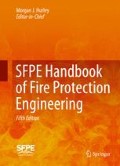Abstract
Hydraulics may be regarded as the application of knowledge about how liquids behave in static and flowing conditions to solve practical fluid related problems. It is generally held to describe the behavior and effects of water in motion in both closed conduits and open channels. In the field of fire protection we are concerned primarily with the closed conduit flow regime. In this chapter we will restrict our discussion to the behavior and properties of water flowing in pipes as the phenomenon of paramount interest, although other fluids such as antifreezes at room temperature and foam/water solutions are similar enough to water that the discussion will be applicable to them as well. Additionally some of the principles presented here also apply to system designs utilizing other fluids such as foam concentrate or antifreeze at low temperatures.
A significant portion of this chapter was written by John J. Titus. Editorial and technical updates were incorporated and additional information on pumps and water supplies have been provided for this edition.
Access this chapter
Tax calculation will be finalised at checkout
Purchases are for personal use only
Notes
- 1.
This discussion is patterned after the theory of water hammer as developed by N. J. Zhukovsky and as presented in Andrew L. Simon’s Practical Hydraulics, 2nd ed. [6].
References
H.E. Hickey, Hydraulics for Fire Protection, National Fire Protection Association, Quincy, MA (1980).
R.P. Benedict, Fundamentals of Pipe Flow, Wiley-Interscience, New York (1980).
V.L. Streeter and E.G. Wylie, Fluid Mechanics, McGraw-Hill, New York (1979).
Pipe Friction Manual, 3rd ed. Hydraulic Institute (1961).
Isman, K. “Darcy Weisbach Friction Loss”, Sprinkler Quarterly, National Fire Sprinkler Association, Winter 2001, pp 27–30.
A.L. Simon, Practical Hydraulics, John Wiley & Sons, New York (1981).
F.M. White, Fluid Mechanics, McGraw-Hill, New York (1986).
Journal AWWA, 73, 5 (1981), by permission. Copyright © 1981, The American Water Works Association.
T.M. Walski, Analysis of Water Distribution Systems, Van Nostrand Reinhold, New York (1984).
D. Stephenson, Pipeflow Analysis, Elsevier, Amsterdam (1984).
NFPA 20, Installation of Centrifugal Fire Pumps, National Fire Protection Association, Quincy, MA (2013).
NFPA 13, Installation of Sprinkler Systems, National Fire Protection Association, Quincy, MA (2013).
Author information
Authors and Affiliations
Editor information
Editors and Affiliations
Nomenclature
- A
-
area
- C
-
proportionality constant or flow coefficient, Hazen-Williams C-factor
- c
-
celerity of a shock wave
- D
-
pipe diameter
- d
-
element diameter
- E
-
velocity of approach factor, bulk modulus of elasticity
- f
-
Darcy-Weisbach friction loss factor
- G
-
gravitational acceleration constant, 9.8 m/s2
- H
-
head of water
- h
-
head
- h c
-
height of centroid
- h L
-
head loss
- I
-
moment of inertia
- K
-
proportionality constant or flow coefficient
- k
-
proportionality constant or flow coefficient
- L
-
length of conduit (in friction loss equations)
- l
-
length or distance
- m
-
mass
- N
-
pump rpm
- p
-
pressure
- Q
-
volumetric discharge rate
- Re
-
Reynolds number
- S
-
slope of energy gradient
- s
-
specific gravity
- u
-
stream velocity at a given point in flow cross section
- V
-
volume
- v
-
average stream velocity
- z
-
height above a reference datum (potential head)
- α
-
kinetic energy correction factor
- β
-
beta ratio
- γ
-
specific weight
- Δ
-
increment
- ε
-
pipe wall absolute roughness
- η
-
efficiency
- μ
-
absolute (dynamic) viscosity
- ν
-
kinematic viscosity
- ρ
-
density
- τ
-
fluid shear stress
Rights and permissions
Copyright information
© 2016 Society of Fire Protection Engineers
About this chapter
Cite this chapter
Isman, K.E. (2016). Hydraulics. In: Hurley, M.J., et al. SFPE Handbook of Fire Protection Engineering. Springer, New York, NY. https://doi.org/10.1007/978-1-4939-2565-0_41
Download citation
DOI: https://doi.org/10.1007/978-1-4939-2565-0_41
Publisher Name: Springer, New York, NY
Print ISBN: 978-1-4939-2564-3
Online ISBN: 978-1-4939-2565-0
eBook Packages: EngineeringEngineering (R0)

